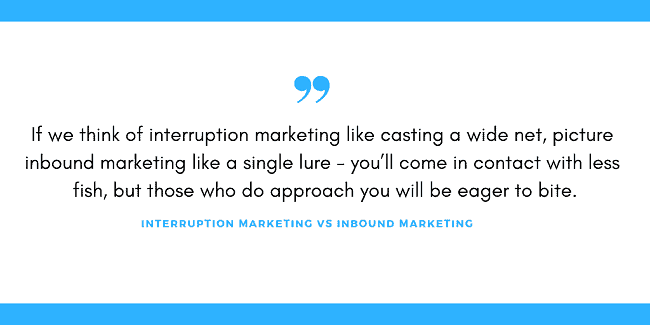According to a 2017 study reported by Forbes, consumers are exposed to 4000 to 10,000 marketing and advertising messages per day. This statistic might be alarming for two reasons:
- As a business owner, you might be stunned to see how much competition you really have in your efforts to market to your target audience.
- As a consumer, you might be shocked to see how many of these messages you come in contact with daily – most of which you aren’t aware of or won’t remember.
While more traditional forms of marketing – also known as “interruption” or “outbound” marketing – might be the most well known to businesses and consumers alike, trying to cast the widest net possible through mediums such as television and print might not always reel in the largest number of eager customers. For this reason, an increasing number of businesses are making the switch towards bolstering their inbound marketing strategies.
What’s the difference between inbound and interruption marketing, and which one is a better fit for your business? Let’s compare.
OUT with the Old: Interruption (Outbound) Marketing
Interruption marketing, or outbound marketing, refers to traditional forms of marketing in which a business initiates contact with their target customer base. When you think of age-old business marketing tactics, you’re probably envisioning common interruption marketing strategies such as:
- Direct mail
- Cold calls
- Cold emails
- Radio ads
- Television ads
- Tradeshows
While there’s nothing necessarily wrong with interruption marketing, the problem lies in the way modern-day consumers interact with this type of marketing strategy. Keeping with the 4000-10,000 marketing messages per day statistic above, think back to every form of interruption marketing you may have come in contact with yesterday. How many advertisements do you vividly remember seeing in your newspaper? How many phone calls from an unknown number did you send to voicemail? How many emails from retailers did you “mark as read” in your inbox?
The challenge with interruption marketing is spelled out in its name – it interrupts your potential customers’ conscious behavioral flow. If they are not already in the market for a business offering products or services like yours, the likelihood of them continuing the conversation after your company’s initial outreach is slim. Simply put, it has become easy for consumers to ignore interruption marketing campaigns when they are inundated with so many similar types of messaging each day.
In addition to the time commitment needed to manage an interruption marketing campaign, business owners will also quickly discover the financial commitment required for a relatively low return on investment (ROI). Larger interruption marketing mediums such as television and magazine ads can cost thousands of dollars per campaign, and even one-time events like a booth at a tradeshow can set you back a few hundreds of dollars. Research suggests that on average, interruption marketing costs approximately $350 per lead. Given that only a portion of leads become sales, your business’ marketing team should expect a low ROI using this type of marketing strategy.
It’s important to note that interruption marketing isn’t necessarily bad, or even outdated. Certain types of businesses – such as retailers or restaurants – might even generate the majority of their clientele base through interruption marketing mediums. However, utilizing inbound marketing strategies in place of a full interruption marketing campaign can prove to serve several major benefits in your efforts to attract eager leads while staying budget-friendly.
 IN with the New: Inbound Marketing
IN with the New: Inbound Marketing
Inbound marketing is the practice of bringing warm, qualified leads into your sales funnel rather than reaching out to cold, unmotivated targets. While interruption marketing hinges on the business initiating a conversation with their target audience, inbound marketing focuses on pulling in customers organically by creating valuable content, promoting marketable content and fostering authentic relationships. If we think of interruption marketing like casting a wide net, picture inbound marketing like a single lure – you’ll come in contact with less fish, but those who do approach you will be eager to bite.
Inbound marketing tactics are much more subtle than interruption marketing tactics – so subtle, in fact, you might not immediately identify them as marketing to you at all. Some common examples of inbound marketing include:
- Search engine optimization (SEO)
- Pay-per-click ads (PPC)
- Social media marketing
- Blogging
- Videos
Inbound marketing works because it lends itself to the way people shop and consume information in today’s society – digitally. Don’t take my word for it – let’s take a look at the impact of inbound marketing by the numbers:
- 68% of online buyers will dedicate a significant amount of time to reading content to a brand they are interested in.
- 80% of business consumers prefer to learn about a brand via an article rather than ads.
- 84% of consumers aged 25-34 have left a favorite website if it’s advertising felt intrusive.
- The average cost per lead drops approximately 80% after 5 months of consistent inbound marketing.
- The average website conversion rate doubles from 6% to 12% with consistent inbound marketing.
While interruption marketing focuses on generating interest through broad outreach, inbound marketing prioritizes generating interest by demonstrating value. This very blog is an example of inbound marketing! It didn’t show up as a flyer in your mailbox or as an intrusive newsletter from an email subscription you didn’t sign up for. You’re reading it because you made the conscious decision to click the link that brought you to this very sentence, whether through a Google search, social media post or directly from our website.
In addition to being more effective at grabbing the attention of motivated consumers, inbound marketing channels typically maintain a low cost advantage. These campaigns are traditionally less expensive to run than interruption marketing campaigns, while maintaining a lower cost per lead acquisition. On average, inbound marketing leads are 61% less costly than interruption marketing leads. If we refer back to the $350 cost per interruption marketing lead referenced earlier, that means you’d be spending approximately $137 per lead acquired through inbound marketing channels – a $213 savings. Not only will you be generating interest and fostering relationships with eager potential customers, but you’ll also be saving money in the process.
 Bring IN New Customers With Inbound Marketing
Bring IN New Customers With Inbound Marketing
While inbound marketing is undoubtedly an effective and cost-efficient method of generating new leads, it’s important to remember that it isn’t the only, right or even best way to market your business. Rather than jumping all in on a costly interruption marketing campaign, consider investing your marketing budget into inbound marketing mediums first. This will help your business attract motivated leads, generate an online following and build credibility while keeping your cost per lead low.
Curious about how changing your marketing strategy could help your business flourish? Reach out to our team to learn more about how adopting inbound marketing methods could help generate a loyal following, convert new customers, and improve your business’ ROI.


 IN with the New: Inbound Marketing
IN with the New: Inbound Marketing Bring IN New Customers With Inbound Marketing
Bring IN New Customers With Inbound Marketing

